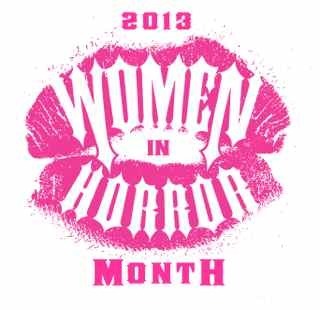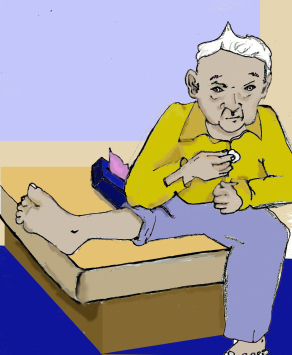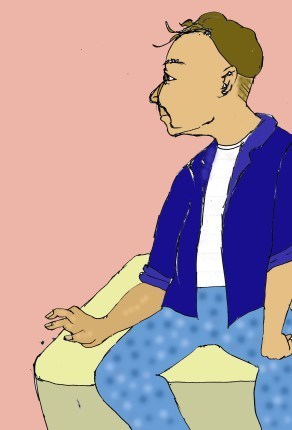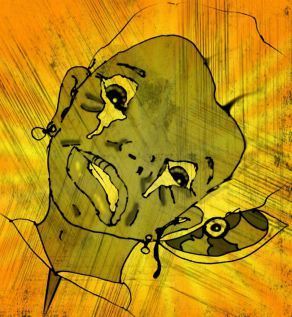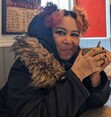Sumiko Saulson's Blog, page 55
February 17, 2013
Interview with Linda Addison, author of “The Four Elements” (air)
This interview is being included in the 2013 Women in Horror Interview Series. Every February, Women in Horror Recognition Month (WiHM) assists underrepresented female genre artists in gaining opportunities, exposure, and education through altruistic events, printed material, articles, interviews, and online support. You can find out more about WiHM here:
http://www.womeninhorrormonth.com/
The Author
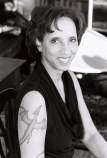
Linda Addision (photo by Chris Lamb)
Three-time Stoker Award winner Linda D. Addison grew up in Philadelphia and began weaving stories at an early age. She moved to New York after college and has published over 200 poems, stories and articles. Ms Addison is the author of “How To Recognize A Demon Has Become Your Friend” Short stories and poetry (Necon E-Books, 2011) and the first African-American recipient of the world renowned Bram Stoker Award. She is the author of four collections: “How To Recognize A Demon Has Become Your Friend” (Necon E-Books), “Being Full of Light, Insubstantial”, “Consumed, Reduced to Beautiful Grey Ashes” and “Animated Objects” (Space & Time Books). Her work has also appeared in numerous publications, including Essence magazine, Asimov’s Science Fiction magazine and Doorways magazine. She is the only author with fiction in three landmark anthologies that celebrate African-Americans speculative writers: the award-winning anthology Dark Matter: A Century of Speculative Fiction (Warner Aspect), Dark Dreams (Kensington), and Dark Thirst (Pocket Book).
www.lindaaddisonpoet.com
The Book
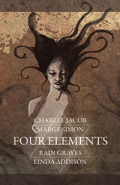
Four Elements
Four Elements: Four Bram Stoker Award™ winning poets join together to paint a rich, dark tapestry of evocative emotion in The Four Elements. From modern interpretations to ancient mythology, they explore the magic and mystery of Fire, Water, Earth, and Air. Their vivid poetry and prose brings to life a universe in a grain of sand, taking the reader through a journey of discovery from the inside out. Hear the hot voice of invisible awareness in Linda Addison’s interpretation of Air. Explore the realm of ethereal and surreal liquidity in Rain Graves’ Water. Burn from crevice to crown in Charlee Jacob’s wild-eyed visions of Fire. Contemplate Marge Simon’s poignant twists of dark irony to eruptions of spontaneous wonder in Earth. There is something for everyone in The Four Elements–conjured especially for the reader that likes to examine the meticulous depth and meaning in every word.
The Interview
Q. Before you started writing, you were an accountant and majored in Mathematics. In that period of time, did you ever imagine that one day you would be an accomplished and award winning writer?
A. No, I didn’t see myself winning awards and I certainly didn’t imagine having close to 300 poems, stories and articles in print. The big dream then was getting published in a publication that you could buy in a bookstore or magazine stand. Growing up the oldest of nine children made me very aware of wanting to have a job that would pay well enough for a comfortable life. I associated being a writer with being poor. Since I was strong in mathematics and science I went that route in college.
I wrote stories and poems before college, even had some published in my high school paper. When I was in college I still wrote for myself and didn’t concentrate on sending any pieces out for publication. I always knew writing would be part of my life but I didn’t get serious about submitting work until I graduated from college and came to New York.
Winning awards always seemed indefinable to me. I loved watching the Olympics and to know that the top five or ten athletes in the world were trying to be the number one seemed unfair so I didn’t think much about winning awards for my writing. Especially since I knew I needed growth with my writing skills to even get published.
Q. Early in your writing career, you were published in “Asimov’s Science Fiction Magazine” – I am a big fan of the publication. How did it feel when you first found yourself published there?
A. I was so happy. Even thinking about that now gives me chills. Isaac Asimov was one of the science-fiction writers that I admired. I had an opportunity to see him a few times before he passed and even had face recognition since there were so few African-American women at science-fiction events.
I still have the first couple of years of the magazine and have maintained a subscription from day one. It took years of sending them anything I wrote that was even vaguely speculative. I collected a lot of form rejections, until one day I got a personal rejection. That was huge, I felt like I was getting closer to being published.
The first time in the magazine was so exciting. I walked about Manhattan, stopping at magazine stands and bookstore just to look at the magazine and see my name in it.
I’ve been published a few times in Asimov’s SF Magazine since then and it’s still wonderful but that first time was unforgettable.
Q. You are the first African American winner of the Bram Stoker Award and have won the prestigious award three times for your poetry collections. You have broken ground for every black writer to follow after. How do you feel about this achievement?
A. When I attended the HWA Bram Stoker© awards years ago I didn’t have anything on the ballot but I remember when Tananarive Due had her first book on the final ballot. I was so excited to meet her at the event because there were so few African-Americans attending. I thought she would win but she didn’t. She is creating an expansive career since then and I’m proud to know her and her husband, author Steven Barnes.
It didn’t occur to me that I would win, even when my first book, “Consumed, Reduced to Beautiful Grey Ashes” made the first cut to the Preliminary Ballot. By the time I got to the Final Ballot I felt like I had already won, seriously. You hear people say that and I know how they feel. The day I found out I was on the Final Ballot I was ready to celebrate.
I was on the Final Ballot with poets who were my idols like Charlee Jacob and Bruce Boston. Chad Hensley was also well published and his book was excellent. No reflection on my book, I loved it (still do) but I was sure Charlee or Bruce would win.
I was stunned and beyond excited when I won and blessed that my mother attended the awards. I made her stand during my acceptance speech because she was such a fantastic storyteller and inspiration for me.
It was only in looking over the past winners later that I realized I was the first African-American to win. I was surprised and humbled. So far I am still the only African-American to win this award but I’m looking forward to someone else jumping into this pool with me.
Q. You did not begin publishing your works until you had some life behind you, and had spent quite a while married and raising a child, something you have in common with Toni Morrison and Alice Walker, who began to create award-winning works in their late 30s and 40s. I didn’t start to write novels until that age myself, so I am wondering if you think that the changes that we go through in mid-life such as freedom from care taking roles, for example, are in any way associated with us finding at last, our voice?
A. This is definitely true for me. When I first started writing it was about personal reactions to the world. Over time, having experienced joy, loss and all the things that life presents I began to write in a broader sense. I listened to the universe around me. My voice expanded and became second nature.
I also spent years writing, making mistakes, working on writing better (which I still do), and writing in different ways to stretch my chops. It has been said we have to write thousands or millions of words before we find our rhythm. There is something to that.
I can remember years ago struggling with dialogue and spending time listening to people talk, reading dialogue that worked, reading my own work out loud until that wasn’t such a big problem. Then I would work on something else that I wanted to make stronger.
Writing is on of the careers that can get better the longer you live because it will deepen your sense of the world, if you allow it.
Q. Women in horror writing are rare, and women of color exceedingly so. Do you think that is beginning to change?
A. I do think this is changing. You created a list of 20 Black Women in Horror Writing. Ten years ago that list would have been much shorter.
Sheree Thomas’ Dark Matter speculative fiction collection, published in 2000 by Warner Books, was an ice breaker that introduced the world to many speculative writers from the African Diaspora. I had been published before but few people knew I was African-American until my story was published in Dark Matter.
It was the beginning of an exciting time. Warner had us doing signings and readings and we got to meet young African-American writers who were interested in the speculative field. I have to believe that anthology helped young writers see themselves published writing speculative fiction.
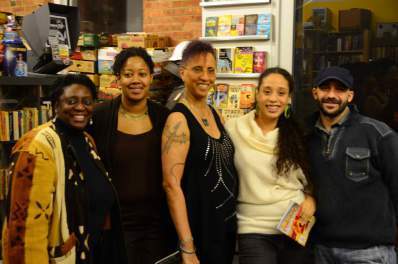
Jenn Brissett, N. K. Jemison, Linda Addison, Alaya Dawn Johnson, and Daniel Jose Older
Q. Do you think that writing poetry is a different experience for the writer than prose?
A. I can only speak for myself, but poetry is pretty much always drifting through my mind. I hear it like background music. I journal every day and jot down bits and pieces which then later become poems or stories. It comes through me like breath.
There’s an instant gratification that happens when writing a poem, even with rewriting I can usually create a finished poem in a day. That doesn’t often happen with a story.
My fiction is character-driven and I take the characters very serious. It takes time to get to know them, what they are willing to do to get what they want, etc. I certainly enjoy writing prose, but it is more work to get the right balance of story, character, tension and resolve.
I have written a story as a poem and vice-versus; it’s a different way of writing.
Q. What can you tell us about your latest award winning work, “How to Recognize a Demon Has Become Your Friend?”
A. The collection is written as a poem/story/poem/story…and covers the spectrum of horror, science-fiction, fantasy. I started working on it after my mother passed. It was so hard to sit down and write but somehow when I started, the flow came back. I’d like to think it was also my mother’s spirit helping me somehow get back to what I was born to do.
The cover is amazing and was done by Jill Bauman. We go way back and I always wanted to have her art on a book but she works with authors like Stephen King and so forth. It was a dream come true to have her do the art. By the way, the hands on the cover are my hands. She took a picture of my hands in that position, but I didn’t know what the cover would look like until she finished it.
This book is a good way for people to start reading my work because it is a mix of poetry and prose. I was truly stunned when they announced my book as the winner because once again I was up against amazing authors.
Q. I also want to know about “The Four Elements” – I know Rain Graves, we did a book reading together back in October. What can you tell us about that book and your role as “Air”?
A. My section, Air, is all new poetry and is a story of a person who suddenly finds themselves transformed into air. The poems follow their journey through time, space, hell and back until at the end they change back into flesh. The poems are structured into six parts, Bardo One to Six. Bardo is a Tibetan word meaning “intermediate state”. I won’t say more than that, but I read quite a bit on the subject in order to use all six. It’s a fascinating concept.
The idea of doing a book of based on the four elements (earth, water, fire, air) by four women who had won Bram Stoker awards came out of a discussion I had with another author, Gerard Houarner. The more I thought about it, the more excited I became at seeing this book happen.
I approached Marge Simon, Rain Graves and Charlee Jacob about the idea and they also loved it. I have known them for many years from writing conferences and admired and loved their work.
I let each of them pick the element they wanted and I was left with Air, which was perfect for me. It didn’t matter what they wrote in their sections as long as the sections were close to the same size.
They created amazing work for this book. I couldn’t be prouder of the final product. The cover by Daniele Serra is fantastic. Marge Simon is a double threat because she is a writer and artist. The full color section dividers are based on us and our elements and are breath-taking. Charlee also has a enhanced photo by her husband, Jim Jacob, in her section that is chilling.
We were so fortunate that Rain talked with Roy Robbins at Bad Moon Books and they ultimately published a beautiful version of book as trade paperback and limited signed edition.
Q. Finally, it has nothing to do with writing, but I love your tattoo. When I saw it I immediately wanted to call you “The Girl with the Dragon Tattoo”. If you don’t mind me asking about it – when did you get it and does it have any symbolism or special meaning for you?
A. Ha, I have been called “The Girl with the Dragon Tattoo” and it makes me smile.
The dragon is a mythical being and represents so much that I could spend a lot of time talking about it. One thing I will share with you is that when I was younger I was very shy and picked on in school. I had a very active imagination and would imagine that they were jealous because I had wings.
I thought for a long time about getting a tattoo and what it would be and where. I am blessed to work with a top rate tattoo artist, Anil Gupta, for the dragon and one that I have on my back (see more about that on my site Galleries/Photo Albums/New tattoo 2008 set).
It took about two and half hours and was worth every second. I’ve never regretted it. When I look at it I smile and feel quite happy to be different.
Q. Is there anything you’d like our readers to know that I haven’t asked you yet?
A. I am part of another book that came out the end of last year that I’m very proud of, Dark Duet.
It is a collaborative book of poetry written with Stephen M. Wilson, inspired by music and is available as a paperback from Amazon as well as an eBook, (publisher Necon eBooks). Cover art by Kiri Moth and interior art by Jill Bauman, includes two separate (a duet) introductions one by Tom Piccirilli and one by Mike Arnzen, both authors that I greatly admire.
Some of the poems we wrote together, some poems were written by one of us in response to the other’s poem. The experience with Stephen (who approached me with the idea) was extraordinary. He’s in California and I’m in New York; it was written through emails and we both worked without egos. The final result is a symphony images and story we hope others will enjoy.
Thank you so much for allowing me to share my opinions with your readers.
Where to Find Linda Online
www.lindaaddisonpoet.com
Listen to her here:
Courtesy of Silver Blade
(see the bottom of http://www.silverblade.net/content/?p=1458)
Land Sharks
Sharp, Shiny, Hurting Things
Bending
Little Red Riding Hood


February 16, 2013
RIP Paul Ash, Writer, Publisher, and Visionary
 Reblogged from Kevin Sampsell:
Reblogged from Kevin Sampsell:
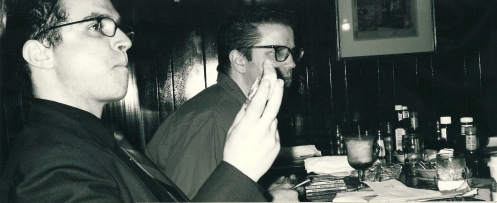
A longtime friend and the man who designed the Future Tense Books website, Paul Ash, took his own life on February 7th in Portland, Oregon. I met Paul around 1999 and for a couple of years we often did readings together and talked about our various publishing projects. I was publishing little Xeroxed chapbooks by various small press writers and he was enthusiastically exploring the world of Internet publishing, first with his website, …
A beautiful commemoration of the life of Paul Ash, who recently passed. This was bought to my attention by Jemiah Jefferson, who deeply respected the man who gave her a chance and published one of her short stories. Remember - whoever you are, your life touches the lives of others, and there is someone who respects you and doesn't want you gone. No matter what you think about how little what you do is, to someone else it is very large - so stay strong. One Love.
Interview with Rain Graves, author of Four Elements (water)
This interview is being included in the 2013 Women in Horror Interview Series. Every February, Women in Horror Recognition Month (WiHM) assists underrepresented female genre artists in gaining opportunities, exposure, and education through altruistic events, printed material, articles, interviews, and online support. You can find out more about WiHM here:
http://www.womeninhorrormonth.com/
The Author
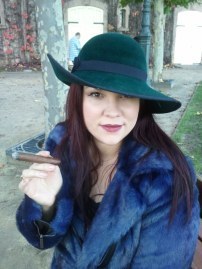
Rain Graves
Rain Graves is a Bram Stoker Award (2002) winning poet and writer currently living in San Francisco. She has been published professionally in the horror fiction and poetry genre since 1997, in various magazines, books, and webzines. Her latest books include BARFODDER: Poetry Written in Dark Bars & Questionable Cafes (2009), and THE HAUNTED MANSION PROJECT: Year One (2012), and THE FOUR ELEMENTS (2013) with Linda Addison, Charlee Jacob, and Marge Simon–four Bram Stoker Award winning poets. Recent short fiction can be found in the popular Zombies vs. Robots comic book series of anthologies – WOMEN ON WAR (IDW, 2012), TALES FROM THE HOUSE BAND volumes 1 & 2 (2011, 2012), and HIGH STAKES (2013). She is a talented spoken word performer, Hostess of the Haunted Mansion Writer’s Retreat, former musician and retired, award-winning dance instructor. For more information on appearances, visit http://www.raingraves.com
The Book
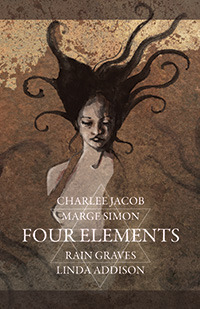
Four Elements
Four Bram Stoker Award™ winning poets join together to paint a rich, dark tapestry of evocative emotion in The Four Elements. From modern interpretations to ancient mythology, they explore the magic and mystery of Fire, Water, Earth, and Air. Their vivid poetry and prose brings to life a universe in a grain of sand, taking the reader through a journey of discovery from the inside out. Hear the hot voice of invisible awareness in Linda Addison’s interpretation of Air. Explore the realm of ethereal and surreal liquidity in Rain Graves’ Water. Burn from crevice to crown in Charlee Jacob’s wild-eyed visions of Fire. Contemplate Marge Simon’s poignant twists of dark irony to eruptions of spontaneous wonder in Earth. There is something for everyone in The Four Elements–conjured especially for the reader that likes to examine the meticulous depth and meaning in every word.
The Interview
Q. February is Women in Horror Recognition Month. Women are still underrepresented in horror fiction writing. Why do you think that is?
A. I think it’s more a factor of there being less women in the past choosing to write horror than men. It’s different for Fantasy, but Horror and Science Fiction have less books published by females than other popular genres. I don’t think it’s because publishers won’t publish them. I think it’s still a male dominated field because of the readership demographics. That’s changing, though. More women are reading horror, and more women are interested in writing horror.When I started going to professional conventions as a writer that had not had much published, out of 200-300 people, there were only a handful of women. Charlee Jacob, Lucy Snyder, Poppy Z. Brite, Nancy Collins, Anne Rice, Nancy Kilpatrick… They were on the shelves, and we all loved reading them. But they only represented a tiny percentage of what was being churned out by the major (and small press) publishers.
When people think of horror, people don’t think of female authors right away. They think of Stephen King, Dean Koontz, Chuck Palahniuk, and Clive Barker. But if you were a teenager that happened to be a girl reading those titles in the late 80′s, you were also consuming summer horror movies, and true crime. V. C. Andrews (posthumously, even) produced one of the most horrific series’ I can remember reading as a teen that wasn’t true crime – Flowers In The Attic. Because horror is more closely associated with men, women who write it are underestimated and often over-looked. They’re out there, though, and writing amazing stuff.
Q. I was very excited to find out that you were a part of the Four Elements project – a book of stories by four female Bram Stoker Award winners, each representing an element. How did you become involved in the project, what can you tell us about it and why (besides your name, of course) did you find yourself attracted to the element of water?
A. It’s a book of poetry, really, with some prose in each section. Linda Addison approached me via email a few years ago and said she had this project she was working on with Charlee and Marge, and needed the fourth element author. I asked if I could choose water, and she agreed, and the rest was all writing and collaborating on what to put in, and how to put it together. It was her brainchild, though. I feel very fortunate and honored that she thought of me.The book itself is a journey through time for each author, and what their respective element was in both history and modern ages, and representative to themselves. We found we were all writing on the same wave-length, though we hadn’t each discussed how our sections would pan out until we were putting it all together, and questioning what worked and didn’t.
I chose water originally because I wanted to work with mythology, as well as modern myths of self. The things our mothers and grandmothers tell us as children and leave us with as adults. How that was for me relating to the flow of time, through water. There is a lot I didn’t cover, but what I did, felt right.
Q. Most of the nominees for the Stoker Awards are men. To be a woman and a Stoker Award winner – that’s rare… how did you feel about receiving the prestigious award?
A. A lot of people have mixed feelings about the Stoker Awards, but for me, it was two things -
1) Recognition for something I may not have even been recognizing as an achievement in myself. As a writer, you just tend to plod along, and send your stuff out, and hope there will be more acceptances than rejections. To be recognized for some of that work, was a great feeling, and I’m grateful.2) I feel it brings awareness, not just for women, but for the category of poetry in general. Horror poetry in today’s world is such a misbegotten thing–a bastard child, maybe, and something that shouldn’t be, but is. In the old days, no one batted an eye at Dante, Keats, Shakespeare, or Tennyson for the poetry they wrote that could have easily been categorized as horror.
When the Bram Stoker Award for poetry began to take shape, no one knew how to judge it, or felt qualified, or felt there were enough books being written to nominate. As more and more authors were doing it and being recognized because people liked reading it, more and more poetry was widely accepted by the horror readership as something they wanted to get their hands on and try.
Today, you can go through all the back years of the Bram Stoker Awards list of winners, and begin with all of the nominees to start reading and getting into it, if you don’t know where to start. You couldn’t do that 25 years ago. As long as people are aware of it, they can read it. That makes me happy.
Q. What was it like working with Marge Simon, Linda Addison and Charlee Jacob on “The Four Elements”?
A. It was easy. Everyone had their work to do, and we all worked very well together. We collaborated equally, made decisions, and enthusiastically read each others work. Collaborations aren’t always easy, but this one was seamless. Everyone was so talented, and genuine. It makes a big difference when you go into a project knowing you respect and admire everyone’s work. It gives you the confidence you need to make a good book and trust in everyone else to make it even better than you thought it could ever be.
Q. When I first met you – when we both read at Blow Salon during Sunday Streets in Berkeley – your reading – I believe from “Barfodder” – had the strongest impact on my nieces, age 22 and 12. They were both talking about it after the show; it was very intense, very memorable. Do you do a lot of readings, and do you enjoy them?
A. I had to really back myself up and make sure I wasn’t reading things that would scar them for life. I hope I didn’t! I always get nervous when kids are there because I have to be aware of appropriateness for the audience. They were smart girls, and I enjoyed seeing them there. I’m glad it was memorable, too–in a good way (I hope)!
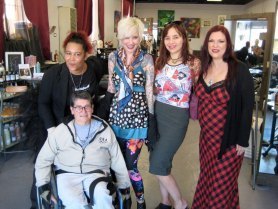
Sunday Streets Berkeley @ Blow Salon: Patty Overland (front), Sumiko Saulson, Serena Toxicat, Rebecca Wilson and Rain Graves
I have done a lot of spoken word performances around the bay area and beyond. I love performing, and I love making people think. It brings the written word alive in a way that your reader might not have ever experienced it on their own. Blow Salon was especially fun because I really dig what they do, and when Serena Toxicat turned me on to the event, I was thrilled to be a part of it. I love listening to what other people are doing, and going to these things are a great way to find great new things. We are lucky in the Bay Area, that there is such a strong literary culture here. It’s incredibly inspiring.
Q. Where do you think the intensity of your work comes from?
A. I’m an intense person, I’ve been told. I think I have no choice with that, though I’ve tried to be softer and more subtle sometimes in my fiction and poetry. It either works or it doesn’t; you write what you know, or it comes out wrong.
Q. Your poetry often integrates the brutality of real, urban themes and slice-of-life style events with the surreal and the supernatural. Do you think the monsters – haiku of a cuttlefish Cthulhu – give the reader respite from the stark terror of the darker corners of the reality we face every day?
A. I think monsters are a great way to escape, but also a great way to see ourselves. What else would we fear more, but becoming a monster, or being victimized by one? Only death, perhaps. It is in understanding monsters, that we understand ourselves–we can see both sides of the story–good and evil, and hopefully in that recognition of yin and yan, we can stay true to our own paths. My favorite monster is the Creature from the Black Lagoon, because he’s the most misunderstood monster of them all. He teaches us to see the good in everyone, even if it’s not obvious, and looks like an ugly truth.
Q. Do you have anything coming down the pike that we can look forward to?
A. I’m working on a few things, but the next two things coming out this year are THE HAUNTED MANSION PROJECT: YEAR TWO, edited by Loren Rhoads (Damnation Books), and some short fiction in a vampire anthology called HIGH STAKES edited by Gabrielle Faust (Evil Jester Press). I’m not sure I’ll get to it this year, but I hope to really dig in to some work on another book of poetry that is dedicated to the Egyptian pantheon, and a Weird Western novella.
Q. Is there anything you want to let our readers know that we haven’t covered already?
A. Good night, sleep tight… Don’t let the bed bugs bite. 
Where to find Rain Online
Find Rain Here:
http://www.raingraves.com
http://hauntedmansionwriters.blogspot.com
Find her Books Here:
via Amazon.com
Cemeterydance.com for Barfodder
Bad Moon Books for The Four Elements
On The Radio/Audio Here:
Here is an audio interview from an event on Halloween at SF in SF. Info: from“The Real Horror Show” reading plus interview – approx. 15 minutes. 10/22/10 event at SFinSF - (broadcast on KUSP 89.9 FM, 6:00 pm PT, 1/9/11, via the Agony Column.
Promos Here:
IDW Publishing has a preview of the Zombies Vs. Robots: Women on War! Anthology


Grief, and a Ghost in Agrippa
Cartoon – My dad eating popcorn
Writing is a way for me to be at one with myself. When I am putting words to paper, the expression of intent is on many levels purer than the convolutions of speech. Speech, with it’s cavalcade of body cues and potentially misinterpreted emotion is a local phenomenon. The further away someone is from my little area of geographic and cultural upbringing, the least likely it is that my regional and cultural dialect will communicate.
Visual art, then, is something else entirely. It is a form where I do not need the specificity of communication that words require. Writing is the cure for my angry anxiety, but painting is the salve upon my grief. That being the case, it is no surprise then that I have spent the period of time between the notification of my father’s dire condition, and his subsequent passing in a matter of mere months, invested in my drawing and painting.
The thing is…my dad’s image keeps showing up in my doodles and sketches.
Dad – Inviting us to sit next to him on the bed
It is not just the picture of my dad eating popcorn, which was drawn while I was visiting him. That one is a snapshot of a memory of the time we ate kettle corn and watched Prometheus on a DVD in the week before Christmas 2012. We were hanging out about once a week then, and that DVD would have been a Christmas present except by then neither I, nor my niece were sure how long he would be able to sit up and watch a movie. It was the last movie we sat up and watched together – ever. My New Years my father’s days of sitting up and speaking were almost over. He died on January 3rd.
And now, my father is a ghost in Agrippa, the graphic novel I’m adapting from the short story or – more likely, like a comic book. It won’t be long enough to be a graphic novel. It will just be an illustrated short story. And somewhere in the middle of it, the ghost of my father will be everywhere, because I can’t seem to stop myself from accidentally sketching him, or from putting his tattoo on characters in the story (the way I put his tattoo on my shoulder blade).
Agrippa
Dr. Tine – a character in Agrippa
“Agrippa” is a dystopic near-future tale that takes place in an unnamed industrialized nation very much like the United States. When foreign creditors demand that the nation repay its considerable international debt or face war it enacts the Dulcetta Reforms, ultra-restrictive laws establishing debtor’s prison, and causing a large number of people – many of them seniors – to go to jail or even face execution if not continuously working to pay off their personal debts to the government. Dr. Tine, an expert in geriatric medicine, is desperately searching for employment at the beginning of our tale, having lost her useful functioning in society as the elders she once treated were rounded up and hauled off to the prison camps. Things were so bad she didn’t think they could possibly get any worse. How very wrong she was.
http://www.drunkduck.com/Agrippa/


February 15, 2013
Interview with Jemiah Jefferson
This interview is being included in the 2013 Women in Horror Interview Series. Every February, Women in Horror Recognition Month (WiHM) assists underrepresented female genre artists in gaining opportunities, exposure, and education through altruistic events, printed material, articles, interviews, and online support. You can find out more about WiHM here:
http://www.womeninhorrormonth.com/
The Author
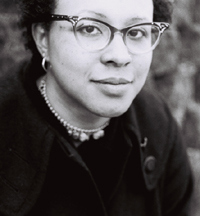
Jemiah Jefferson
Jemiah Jefferson was born in Denver, Colorado. Her childhood consisted of a steady diet of AM radio, New Wave and disco, music videos, Star Wars, horror movies, voracious and indiscriminate reading, and hours of daydreaming; all of these influences can still be found in her writing.
Her first printed work, St*rf*ck*ng, a group of short erotic stories with a touch of celebrity obsession, was published by local small-press rockstar Kevin Sampsell for Future Tense Books.
The hero of nerdy black women everywhere (me included), Jemiah Jefferson is like a superhero: comic book editor by day, author by night. No… seriously, editing comic books is her day job. She works at the editorial department of Dark Horse Comics (my fiance just said “hell ya!). Her Gothic Horror series “The Vampire Quartet” begins in San Francisco with the adventures of Daniel Blum and then follows his extended vampire family across the ocean and back in time.
(Photo by Serena Davidson)
The Book
Mixtape for the Apocalypse
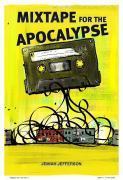 Michael Squire is an average music-obsessed twenty-three-year-old Portlander, juggling a job as an internet support technician, an indie comics gig, and a long-simmering crush on his best friend, Lise. He smokes too much weed, drinks too many cocktails, and watches too much Star Trek. And when his co-workers, baristas, and friends begin to turn on him one by one, his good-natured paranoia expands into a chilling, terrifying certainty about the end of the world. A dark, funny, terrifying novel about a young man who slowly but surely loses his grip on reality, but never on his taste in music.
Michael Squire is an average music-obsessed twenty-three-year-old Portlander, juggling a job as an internet support technician, an indie comics gig, and a long-simmering crush on his best friend, Lise. He smokes too much weed, drinks too many cocktails, and watches too much Star Trek. And when his co-workers, baristas, and friends begin to turn on him one by one, his good-natured paranoia expands into a chilling, terrifying certainty about the end of the world. A dark, funny, terrifying novel about a young man who slowly but surely loses his grip on reality, but never on his taste in music.The Interview
Q. First of all, I wanted to say that just reading your blog is enough to let anyone see how engaging and humorous your writing is. How important do you think humor is in horror?
A. I find humor to be important in everything, even that which is seen as inappropriate… I love a good morbid, tasteless joke after a huge tragedy. It gets life back on track in a way. In horror, a dash of humor can enliven a generally grim story – in the same way, it reconnects the reader to “life”, to the process of getting on with it despite everything, and it humanizes, putting characters on a more even playing field. Not to mention the fact that I, like a lot of other readers, prefers a protagonist (or at least major character) who is funny now and then.
Q. You are a self-described “geek” – do you think that it is a function of the genre that it attracts geeks? I mean that in terms of the geekiness of horror fans.
A. I don’t think that horror attracts geeks more than the general non-geek population; horror is a very popular genre in all walks of life, as far as I’ve been able to determine. Even normals and squares appreciate a good thrill and scare now and then. For the more popular horror authors and films, the majority of the paying audience aren’t geeks. However, it’s very easy for geeks to geek out about horror because it’s such a wide, deep, diverse genre that can depict everything from romance to family stories to politics, but fundamentally is about character – the story of something awful that happens to someone, and how it changes them, even if it only changes them from alive to dead.
Q. You seem to have a well-developed and grassroots and vocal fan base online. I read at least two articles when researching mine where people were all like, “why isn’t Jemiah Jefferson on this list?”. Do you think the internet is helping people to become more aware of you in particular and black women in horror in general.
A. The internet is my major playing field in terms of fan outreach and publicity. I don’t have a lot of money, and I haven’t had much publisher support since the first year of my first novel release, so if I am to have any kind of contact with fans or the like-minded, the internet is the fastest and cheapest way to communicate with them. When an author hasn’t much money or external support, she has to do everything herself, and these days, most people use the internet. I have also been active and vocal in a lot of different “fandoms”, including music, films, television, and genre literature including comic books, and thus it’s all about striking the balance between “Oh, yeah, I wrote some books you might like if you’re into this, because it was inspired by this” and trying not to turn some other locus of fan engagement into something all about me. I have been perhaps too restrained!
Q. Speaking of fans, do you think that fan fiction helps writers in the genre to develop their voices?
A. I am a firm believer in fan fiction as a way of not just engaging emotionally and creatively with a work, but if there’s also a dedication to the craft of writing and composition, getting lots of practice actually doing it is a great way to learn the rules (and how to break them). Fanfic’s got a reputation for being poorly-written, but that isn’t just a characteristic of fanfic; it’s everywhere in published writing. There were shitty books written before fanfic became a better-known phenomena, and there are shitty ones still being written – some of them are fanfic and for some reason have gotten really popular. It’s all about what readers will tolerate.
Q. This is Women in Horror Month. It celebrates women in all aspects of horror, but I want to talk about writing. Women still remain underrepresented in horror fiction, and I was wondering what your thoughts on the matter are. And do you think it is starting to change?
A. I would say that women are underrepresented in publishing in general, and certainly in the books that get a lot of press. However, yeah, I’d say that’s changing. A lot of great horror books are coming out that were written by women; they just don’t get as much press. Also, I think that in the past, women may not have been as interested, or as confident in their work in horror, but the explosion in young adult titles, especially in the realms of “dark fantasy”, are changing that somewhat. Women are definitely present as horror fans, though perhaps more in movies than in books, but I’m willing to bet that that’s changing, too.
Q. It is also Black History Month – and black women writing horror are even rarer. I started to put together a list, and your name is one of the higher profile ones on a very short list of about twenty. Do you have any thoughts as to why black women are so underrepresented in horror writing?
A. I really am not sure; I only know my own story, my own background, and my own interests. I would hesitate to claim that publishers are less interested in works by black women, but there might be something to that; there’s an assumption in the marketing and publicity departments of publishers that an author with a “black” name will only appeal to black audiences, and it’s just not true in my experience, but it’s probably different for others. I’d like to think that this assumption is also changing, but it will take a massive horror bestseller by a female black author to really change the tide. It’s a shame that the world lost L.A. Banks; I think she had the best chance of breaking through that ceiling of any of us. Ideally, that blockbuster best-selling black female author is out there, and her big break is simply yet to come.
Q. I think the “urban fiction” genre is making it a little easier for writers of color to enter the market, but then there seems to be a lot of genre confusion associated with it: for instance, I included L.A. Banks on my list, but some people think she wrote urban fantasy not horror. What do you think about this genre confusion and do you think there is any kind of pigeon holing involved?
A. Again with the “if it’s written by a black person, only black people will want to read it.” I hesitated to use my own name and my photo in my first novel publication, but then I decided to just go for it; I have nothing to hide, and nothing I WANT to hide, and perhaps I could start that sea change happening where black women were taken seriously outside the Toni Morrison, Oprah’s Book Club literature realm, or the (mostly unknown to most audiences) “urban erotica” of writers like Zane. “Urban” is just a marketing euphemism for “black”, because you wouldn’t hear of a inter-city story about Irish kids in Boston referred to as “urban” (or Jame Joyce for that matter; “Dubliners” is urban as hell!) It’s just another pigeonhole, necessary for marketers and the people who shelve books in stores. Perhaps with the decrease in the amount of brick-and-mortar bookstores, the categories will become a little more slippery. Why can’t we all just write literature with elements of shocker, technothriller, romance, philosophy, even travel?
Q. What can readers look forward to seeing next from Jemiah Jefferson?
A. Good question! I’ve been working on BEFORE AND AFTER MICHAEL, my first planned “just plain erotica” novel for the last four and a half years; I keep getting discouraged, or overwhelmed by the other vagaries of life including a stressful job, major health issues, and barely keeping my head above water financially (in other words, the same thing pretty much every other writer is going through), but the novel is almost finished. I hope to find an agent, which I haven’t had since 1998, who may be interested in getting the vampire novels back into print in 2014. I have a couple of other novels written and all-but-finished, but they need to be professionally edited, and in some cases, transcribed from hard copy, before they can be seen by professionals. I just want to sell one of these books. I’ve written a ton since A DROP OF SCARLET, the fourth vampire novel, and I’ve just gotten an idea for a fifth (and sixth) book in the series. I’d love to get the chance, but I really do need to be paid better to do it.
Where to Find Jemiah Online
Jemiah’s website http://www.jemiah.com
Jemiah’s Amazon Author Page
Amazon listing for MIXTAPE FOR THE APOCALYPSE


February 14, 2013
Interview with Marge Simon, Author of Vampires, Zombies, & Wanton Souls
This interview is being included in the 2013 Women in Horror Interview Series. Every February, Women in Horror Recognition Month (WiHM) assists underrepresented female genre artists in gaining opportunities, exposure, and education through altruistic events, printed material, articles, interviews, and online support. You can find out more about WiHM here:
http://www.womeninhorrormonth.com/
The Author
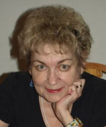
Marge Simon
Marge Simon’s works appear in publications such as Strange Horizons, Niteblade, DailySF Magazine, Pedestal Magazine, Dreams & Nightmares. She edits a column for the HWA Newsletter and serves as Chair of the Board of Trustees. She has won the Strange Horizons Readers Choice Award, the Bram Stoker Award, the Rhysling Award and the Dwarf Stars Award. Collections: Like Birds in the Rain, Unearthly Delights, The Mad Hattery, Vampires, Zombies & Wanton Souls, and Dangerous Dreams. Member HWA, SFWA, SFPA.
The Book
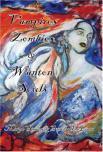
The Book
Vampires, Zombies, & Wanton Souls features over 50 poems written by Marge Simon, each of which is accompanied by Sandy DeLuca’s black-and-white and full-color illustrations. Also included are two stories, DeLuca’s “Tricks of Light,” and Simon’s “Confessions of a Visually Challenged Vampire.
“Marge Simon is an artist, and Sandy DeLuca is a novelist/poet. But Simon is also a prize-winning poet, and DeLuca, we discover to our delight, is an artist with a lavish and luscious eye. “
-Mary Turzillo
The Interview
Q. Thank you for being with us for Women in Horror Month as a part of our WiHM2013 interview series. First I wanted to ask – are you familiar with Women in Horror Recognition month, and what do you think about trying to remedy the under representation of women in the genre?
A. Thanks for having me, Sumiko. Last year, I conducted a “survey” of woman writers in horror on the lines of this topic for the HWA Newsletter. Some were satisfied and some were not –I’d say it was about equal. Some editors said the representation was less because they didn’t get as many manuscripts from woman as men. Personally, I think it’s great that you’re featuring these interviews to raise awareness in both women and men involved in publishing.
Q. You are a Bram Stoker Award winner. How did it feel to win the prestigious award?
A. Over the moon!
Q. What was it like to work with three other Stoker Award winning women writers on “Four Elements”?
A. A positive experience. We all highly respect one another’s works and talent.
Q. The elements were Marge Simon (Earth), Rain Graves (Water), Charlee Jacob (Fire) and Linda Addison (Air) – how did you come to choose “Earth” and what did it symbolize to you?
A. First, I’d like to say that we each picked our sections without knowing what the others chose and all four of us picked the element that *spoke* to them best. I relate to all powers of the earth, and revere trees and mountains. (Perhaps because I grew up in the Rockies!) The Earth Mother, The Living Tree = symbols of my love and respect.
Q. Now you have a new book out – “Vampires, Zombies, & Wanton Souls” – all of the poetry and short stories in the book are written in response to the paintings of Sandy DeLuca. What inspired you to take this approach?
A. Ah, the stories were not in response to paintings. We each had a rather amusing/odd piece and decided to include them. Mine hadn’t appeared in print, but Sandy’s had.
As an artist myself (and retired art teacher), I’m equipped to appreciate art and poetry and find links between them; inspiration and interpretation play a strong part of that. I’d been writing ekphrastic poems for years before I learned there was a word for responding to works of art in poetry and prose.
Q. Some of the works are dark and twisted, but others have a lot of whimsy and humor in them, like your poem about Cleopatra. Is this in response to something you sensed within the painting you were inspired by, and how so?
A. Let’s say I sensed “Cleo” as I refer to her in Sandy’s art. Serendipity played a large part in conjuring that poem. The painting of an Egyptian woman is loosely rendered and a little wicked. Why not she be the tool of a vampire, rather than the Queen of the Nile as she’s known in history?
Q. Zombies and vampires are a big part of the popular culture right now, especially zombies. Why do you think people have such a fascination with the undead these days?
A. Er, I don’t know. I’ve had more than enough of (how many years, now?) zombie stuff, but it keeps seeping back into my life either as poetry or for illustration work.
Q. Is there anything you’d like to tell our readers that we haven’t covered yet?
A. Yes. I’d like to thank specialty press editor and/or publishers such as Roy Robbins (Dark Moon), Joe Morey (Dark Regions), Greg Gifune, Shane Staley (Dark Fuse & Leisure) and Angela Craig of Elektrik Milk Bath Press for supporting and showcasing women in poetry and prose.


More Black Women in Horror Fiction
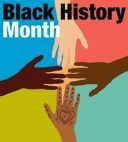 I am really excited that so many people have read and reposted the article 20 Black Women in Horror Fiction. In fact, it’s gotten so much exposure that I’ve had even more women suggested to me who can fit on the list, so I will be revising it over the 4 day President’s Day weekend (I am in school all day today). Even more excitingly, I have multiple interviews I will be posting over the weekend. It’s a good thing it’s a long one.
I am really excited that so many people have read and reposted the article 20 Black Women in Horror Fiction. In fact, it’s gotten so much exposure that I’ve had even more women suggested to me who can fit on the list, so I will be revising it over the 4 day President’s Day weekend (I am in school all day today). Even more excitingly, I have multiple interviews I will be posting over the weekend. It’s a good thing it’s a long one. 
I am going to try my best to come up with ANOTHER 20 women. But so far I only have 4 on the new list I am working on: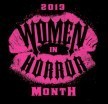
Nisi Shawl
Jewelle Gomez
Monica Jackson (Dark Thirst)
Donna Hill (Dark Thirst)
Can you think of anyone else who isn’t on this list or the first list below?
20 Black Women in Horror Fiction
If you can think of any other black women in horror fiction writing who do not appear on the lists let me know so I can get them on the new list.


A Bittersweet Valentine, The Moon Cried Blood

Sumiko Saulson
I am very pleased to profile other writers in the genre and to highlight what they do – because aside from the struggles we face as women in horror, and as women of color in this genre, aside from all that we are also working in a niche, a genre, that is much maligned. For that reason – because horror is that weird auntie of a genre we like to keep hidden in the kitchen during the big family reunion of writing genres, shielded behind her slightly more respectable cousins Science Fiction and Fantasy – because horror is that ugly duckling sister with a heart as deep and murky as the bottom of the ocean, filled with wonders unforetold – I am happy to lend whenever I can any legitimacy and sense of fraternity – or sometimes sorority? – with other writers of the genre as I can, whenever possible.
Still – sometimes I forget that I am an author and like every other author, there are times when what I really need to do is stop and plug my book. This is one of those times – but bear with me. There is something important about “The Moon Cried Blood”, and a reason why it is free not just on any day during WiHM, but today – Valentine’s Day.
A Coming of Age Story about a Girl
“The Moon Cried Blood” is a horror story that neatly occupies the Coming of  Age genre niche, and falls just short of being a work of Young Adult fiction due to it’s mature subject matters involving death, domestic violence, mental illness and incest. In fact it shares something in common with J.D. Salinger’s “Catcher in the Rye”‘ in that it is a story about a youthful protagonist who lives in a world so dark and fraught with danger that it is clearly written for older audiences – adults, although it is appropriate for older teens.
Age genre niche, and falls just short of being a work of Young Adult fiction due to it’s mature subject matters involving death, domestic violence, mental illness and incest. In fact it shares something in common with J.D. Salinger’s “Catcher in the Rye”‘ in that it is a story about a youthful protagonist who lives in a world so dark and fraught with danger that it is clearly written for older audiences – adults, although it is appropriate for older teens.
Leticia Gordon is thirteen years old in 1975. She hasn’t had it easy: she’s been living with her stepmother and half sister since her father died because her mother is in a mental hospital and can’t take care of her – and now strange things are happening to Tisha – she is seeing this and hearing things she shouldn’t. In an increasingly dark and twisted Los Angeles, young Tisha finds herself struggling with a dark and surreal landscape of frightening events both natural and supernatural. She doesn’t know who she can trust – indeed, she doesn’t even know if she can trust her own mind. Is she, like her mother, insane? Or is the reverse true – is her mother, like her, perfectly sane but experiencing the world through the troublesome veil of her supernatural powers?
A Story About Women and Power

Free Today for Valentine’s
Leticia isn’t losing her mind – she is the last in a long line of witches who have been imbued with their powers by the Moon. They are called the Luna – daughters of the moon spirit – and have gifts of foresight, hindsight, insight and intuition, each according to her bloodline. The future of mankind hangs in the balance as Tisha – the last remaining witch through which the Lita, an all powerful witch who has the power of all four bloodlines at her disposal.
Because of the prophecy, Tisha is in dire straits – some wish to corrupt her so that she will bring into the world a Dark Lita, one who uses her powers for destruction. And someone else wants to stop the prophecy by trying to kill her…
Alone in the dark gritty streets of urban Los Angeles, this little girl is running for her life, trying to figure out what is real and what is a part of her imagination, and who – if anyone – she can trust.
I hope you’ll check it out…
It’s free today, here…
http://www.amazon.com/The-Moon-Cried-Blood-ebook/dp/B007P9WL4W


February 13, 2013
The Face of Horror by Hollis Jay (Guest Blog)
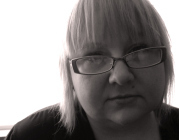
Hollis Jay
In honor of Women in Horror Month 2013, I have invited guest blogger Hollis Jay to come speak to us about her feelings regarding Women in Horror. The author of the novel “The Ever” and a poetry anthology “The Control Room (or the demands of Heather)”, Hollis Jay is an up and coming author focusing on the Gothic and horror genres. She also works in the realms of poetry and nonfiction.
She graduated with her BA in English and  American Literature and MFA in Creative Writing specializing in fiction. She is continuing her educational goals and currently working on her MA in English focusing on with a focus on Gothic literature. She is the haunted mind behind the blog and podcast “Myriads of Thought”, and you can find out where to catch up with her on the internet at the end of this post.
American Literature and MFA in Creative Writing specializing in fiction. She is continuing her educational goals and currently working on her MA in English focusing on with a focus on Gothic literature. She is the haunted mind behind the blog and podcast “Myriads of Thought”, and you can find out where to catch up with her on the internet at the end of this post.
The Face of Horror
Women writers are the salt of the Earth. Their ears are to the ground and they are listening to the streams of consciousness that happen all around them. They hold the power of life and understand death’s despair.
In his book, “Unforgettable Ghost Stories by Women Writers,” Mike Ashley states that “women writers [tend] to be more prolific than men” and that “it is to the legion of woman ghost-story writers that we owe that depth of humanity in the ghost story”. I believe that women also provide a sense of isolation and loss of identity that men do not always focus on within their writing (Ashley vi).
The horror genre is a complex machine. Yes, it offers gore and mayhem but it also creates a sense of strength and purpose within its audience. It gives them the will to carry on and become meaningful in their own right. Horror allows us to find our own true selves and initiate our lives into what we were meant to be, to discover what living never allows; and that is how much we are willing to fight for our lives and the lives of those that we love.
From the beginning, women have been relegated to the belief that our voices do not matter, that we do not count. In the world of horror, we can change this and become strong women who persevere and who are willing to supply our own special points of view to the fight. This viewpoint hinges on the power of our character. Character defines us as women, as human beings, and allows us to stand tall.
These creatures that we become entangled with, these ghosts that cause pain and loss, these merciless beings brought back from the dead have nothing on the strength of a woman and so, when we go to write we control them and their actions. Women understand a type of loss and affliction that men cannot even begin to fathom.
We are the bearers of bad news; the caretakers; the mothers; the motherless; we are the storytellers and in that aspect we are the true authors. Horror allows us to work out our grief. In subtle details, in extreme hardship and somewhere in-between, horror allows us as women to dig out of the grave that has been dug for us, and to transplant our feelings into our work. We kill off the evil. We save lives. We battle against unseen forces. This is our job. It is our time.
The horror genre has created a space for women to become dark and disturbed and to try and understand the misfortunes in the world. It has allowed us to collect our thoughts and no matter how twisted or filled with misfortune, we have been given license to express them in this venue. In this world, our world, we can kill off who and what we want and we can walk away free of guilt and with peace of mind. Although we may reflect upon our choices, we are satisfied with the outcomes and the peace that it brings.
As a woman, I have made writing horror a part of my life. This genre has always called to me and made me feel empowered and safe. I felt as if I could travel in this world with deliberate honesty and write things that I would be afraid to otherwise. Within the horror genre, I found a place of personal reflection that allowed me to understand my life and the lives of others. Horror is the only genre that can do this, that can create a release and a sense of purpose through its words. Others may try to make you believe, but there is only one genre that makes us remember how lucky we are to be alive.
Women are the heartbeat of this genre. We dictate our own fate. We stay strong in a time of war. We pursue the evil and the villains of this world and the next in perfect harmony. We can balance the forthcoming agonies and beat them at their own game. In the end, women rise from the ashes and tell our own story. We collect our minds and our hearts and fly free towards another day. In this genre, we make own rules and regulations and answer to no one but ourselves.
Works Cited
Ashley, Michael. Unforgettable Ghost Stories by Women Writers. Mineola, NY: Dover Publications, 2008. Vi. Print.
Catching Up With Hollis Jay
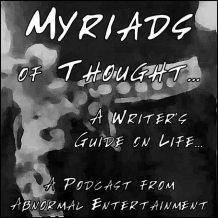 Check out Hollis Jay every week on her blog and podcast from “Abnormal Entertainment” entitled “Myriads of Thought.” You can also find “The Ever,” her novel of the history of a haunted house on both Amazon Kindle and in print on Lulu.com. Her poetry collection entitled “The Control Room or the demands of Heather” can be found in print on Lulu as well. Ms. Jay is currently working on her new novel “Like the universe gasping for air”and hopes to have that and her new poetry collection “Searching for Solace” out in print soon.
Check out Hollis Jay every week on her blog and podcast from “Abnormal Entertainment” entitled “Myriads of Thought.” You can also find “The Ever,” her novel of the history of a haunted house on both Amazon Kindle and in print on Lulu.com. Her poetry collection entitled “The Control Room or the demands of Heather” can be found in print on Lulu as well. Ms. Jay is currently working on her new novel “Like the universe gasping for air”and hopes to have that and her new poetry collection “Searching for Solace” out in print soon.
http://myriadspodcast.blogspot.com/


African American Horror Writers Part 2
I am so excited to be one of the writers profiled in this article on Horror Addicts!
African American Horror Writers Part 2.



